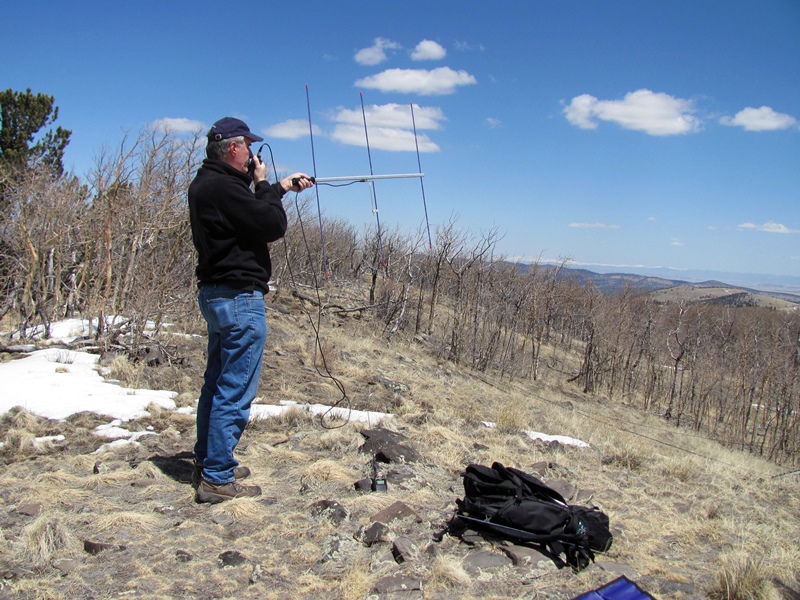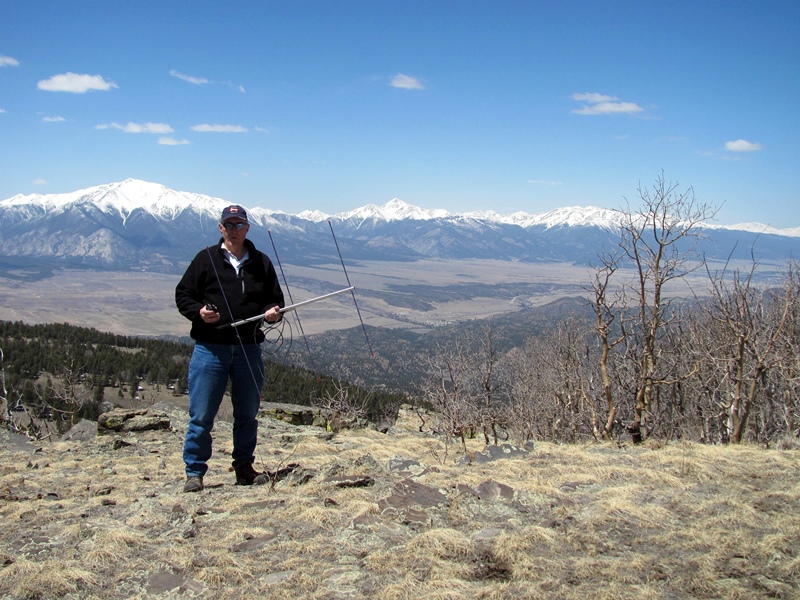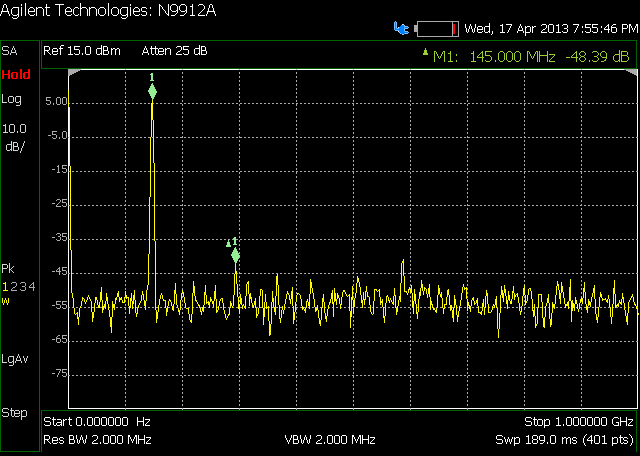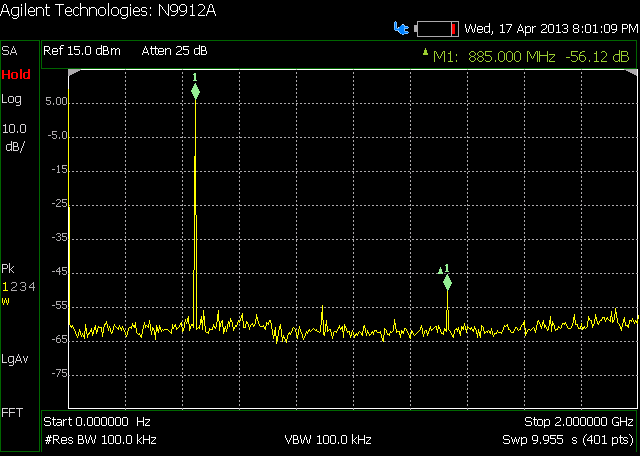Posts Tagged ‘VHF’
 SOTA Activation: Aspen Ridge (W0/SP-084)
SOTA Activation: Aspen Ridge (W0/SP-084)
Spring is finally coming to the Colorado high country so it was time for a SOTA (Summits on the Air) activation. I don’t know which idea comes first: let’s go hiking or let’s play SOTA. I suppose it doesn’t really matter.
I’ve had my eyes on activating Aspen Ridge, which is near our family cabin but I wasn’t sure if the road was open. It turned out to be an easy Jeep ride down Forest Service Road 185 to get close to the summit. Then a half mile hike around and over the occasional snow patch got Joyce K0JJW and me to the summit.
My portable station was a Yaesu FT-60 handheld and a couple of antennas. Shown above is my dualband Arrow II antenna with only the 2 Meter elements installed, resulting in a 3-element Yagi antenna. My other antenna is an omni-directional MFJ-1714 1/2-wave whip antenna, which is a little easier to handle for general use. Often that is the only antenna I bring along but this time I decided to add a few more dB of signal by using the Yagi. I also take along a Yaesu VX-8GR that pings my location on APRS (www.aprs.fi/k0nr-7).
After a few calls on 146.52 MHz FM, I worked KC8I in Woodland Park. A few minutes later, I caught Steve WG0AT operating from another SOTA peak (Mt Herman, W0/FR-063) for the QRP To The Field contest. A little later, I worked Ted N0ZPX who was fishing at Antero Reservoir, then N0VXE mobile near Salida and Ron N0MQJ in Ranch of the Rockies.
This photo shows the beautiful Collegiate Peaks in the background, with plenty of snow still showing. Needless to say, it is a gorgeous view from Aspen Ridge!
73, Bob K0NR
 Checking Out A Baofeng UV-5RA
Checking Out A Baofeng UV-5RA
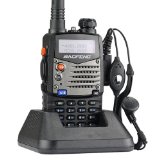 In the Winter 2013 issue of CQ VHF magazine, I wrote about some of the VHF/UHF handheld radios available from China. In that article, I reported on the measured performance of a few of the Wouxun and Baofeng transceivers. One of the Baofeng UV-5R radios that I tested showed harmonic distortion that was a bit high on the 2 Meter band, around -40 dBc.
In the Winter 2013 issue of CQ VHF magazine, I wrote about some of the VHF/UHF handheld radios available from China. In that article, I reported on the measured performance of a few of the Wouxun and Baofeng transceivers. One of the Baofeng UV-5R radios that I tested showed harmonic distortion that was a bit high on the 2 Meter band, around -40 dBc.
I recently got my hands on a Baofeng UV-5RA, which is a newer version of the same radio (firmware BFB297), so I wanted to check its performance. Like the two UV-5R models I checked, the power output, transmit frequency and receiver sensitivity were all quite solid on both bands. I was more interested in the harmonic distortion present in the transmit signal.
On the 2 Meter band, the 2nd harmonic measured -48.4 dB relative to the fundamental which is pretty good. Similar to the other radios I measured, the performance in the 70 cm band is a lot better (-56.1 dB).
This radio has significantly better harmonic distortion than the older UV-5R radio. Of course, this is just a single sample, so performance of other radios may be different.
73, Bob K0NR
 FCC Grants Waiver on TDMA
FCC Grants Waiver on TDMA
 From the That Took A Long Time department, the FCC granted a waiver requested by the ARRL that clarifies the rules concerning the use of TDMA (i.e., MOTOTRBO or DMR) on the ham bands. I posted on this topic way back in March 2011, so refer to that article for the background. Update: ARRL article posted here.
From the That Took A Long Time department, the FCC granted a waiver requested by the ARRL that clarifies the rules concerning the use of TDMA (i.e., MOTOTRBO or DMR) on the ham bands. I posted on this topic way back in March 2011, so refer to that article for the background. Update: ARRL article posted here.
I was surprised to find that the FCC quoted my comments that I filed on this proceeding:
Some commenters state the proposed rule change “removes an ambiguity in Part 97 concerning the use of single slot TDMA technology” and it “enable[s] and encourage[s] the adoption of spectrally efficient narrowband technology.” Comments of Robert Witte at 1.
OK, fine, it was buried in the footnotes but I appreciate the mention. I can now die in peace knowing that my name is in the FCC record and not associated with a rules violation ![]()
Thanks to Jeff K0RM, for pointing this out.
73, Bob K0NR
 DXMaps needs your support!
DXMaps needs your support!
The DXMaps website run by Gabriel EA6VQ needs your support. This is the site that plots contacts spotted to the DX Cluster on a map, band by band, to show propagation in real-time. It is especially invaluable during the summer Sporadic-E season to track the rapidly-moving band openings.
 |
| DXMaps plots DX contacts band by band in real time |
The trouble with any web site is that if it becomes very popular the costs of running it grow beyond what most people can afford as a hobby. According to EA6VQ the cost of a new dedicated server for the site will be $250 a month. So he is asking users to become “supporter users” by donating $33 US per year. But any donation is welcome.
If you are an active operator, especially on six metres and up, you will know how invaluable DXMaps.com is. Hopefully hams will step up to the plate and send Gabriel a donation.
 This Interference Seems to Follow Me Everywhere
This Interference Seems to Follow Me Everywhere
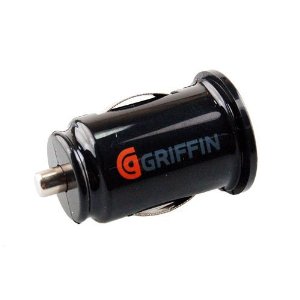 A few weeks ago, I was at my day job working diligently on something. I popped up the SotaWatch web site to see of anyone was out activating SOTA summits. Sure enough, Steve (AKA Goathiker, AKA WG0AT) was headed up Mt Herman for the day. (I have recently declared Mt Herman to be the Most Radioactive Summit in Colorado…at least for amateur radio.)
A few weeks ago, I was at my day job working diligently on something. I popped up the SotaWatch web site to see of anyone was out activating SOTA summits. Sure enough, Steve (AKA Goathiker, AKA WG0AT) was headed up Mt Herman for the day. (I have recently declared Mt Herman to be the Most Radioactive Summit in Colorado…at least for amateur radio.)
When I had a few minutes break, I went out to my amateur-radio equipped SUV in the parking lot to call Steve on 146.52 MHz. Steve came back to my call and we made a quick contact and he was in the log. Even though he was an easy line-of-sight path away, I had trouble copying him. Opening the squelch revealed that I had a large noisy signal sitting on 146.52 MHz. I didn’t think too much of it and assumed it was coming from the vast array of electronic equipment inside the building.
As I left work that day, I tuned to 146.52 MHz to see how quickly the interference disappeared as I drove away. I was surprised to find that the interference did not go away, it was covering a wide area. On my commute home, the noise was remarkably constant. This interference seems to follow me everywhere! Eventually, it sunk in that the interference was coming from my own vehicle. Huh, I didn’t have that problem before.
When I arrived home, I turned off the ignition and the noise was still there. I started disconnecting everything in sight, trying to make the noise disappear. Finally, I unplugged the cute little USB charger/adapter that was inserted into the cigarette lighter socket. Bingo, the interference disappeared. It seems that this little adapter has a switching circuit in it that is generating a large amount of hash. I have not investigated it fully, but it trashes out a substantial portion of the 2 Meter ham band.
It used to be my favorite adapter. Buyer beware.
73, Bob K0NR
 GNT Shirts Now Available
GNT Shirts Now Available
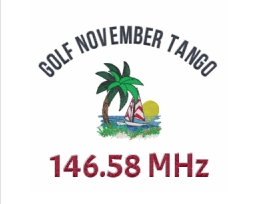
The Committee to Preserve Golf November Tango is pleased to announce the availability of the new GNT Polo Shirt. The origins of the GNT frequency traces back to the incident when three ham radio operators found themselves stranded on the shore of Lake Michigan, calling out in desperation for Gin and Tonic. You may recall the unfortunate circumstances that caused confusion about the correct Golf November Tango calling frequency.
Fortunately, this has all been cleared up and The Committee has authorized the sale of the Golf November Tango shirt, with the official GNT frequency embroidered on it. (It seems that the group is really bad at documenting things, so they figured that if they all had a shirt with the frequency written on it, it could only help. See the logo shown to the left.)
These awesome polo shirts are available online in both mens and womens sizes at the Ham Radio Techwear store. The committee apologizes that these shirts are a little late for Christmas presents, but there is always next year.
Remember, when all else fails, make a call on the GNT Frequency.
73, Bob K0NR
 Bdale KB0G Makes Stuff!
Bdale KB0G Makes Stuff!
Last week, I had lunch with an old friend, Bdale Garbee (KB0G). Bdale and I had both worked at HP for a number of years and we have been involved in some common ham radio clubs and activities. I followed the test and measurement path with Agilent Technologies when that company was formed, while Bdale stayed with the HP computer business. He is a recognized industry expert in Unix, Linux and all things open source. It is always cool to catch up with him and find out what he has been doing. He recently took early retirement from HP…I am not sure what “retirement” means for Bdale but its not playing shuffleboard at the retirement home!
Coincidentally, a few days later, I came across this video from HamRadioNow of Bdale talking at the ARRL/TAPR Digital Communications Conference. In this talk, Bdale discusses the general theme of making stuff and the satisfaction that is derived from that activity. It is about an hour long so grab a cup of your favorite beverage and take a seat.
By the way, check out the other HamRadioNow videos, especially the videos of the DCC technical talks. Good stuff!
73, Bob K0NR
